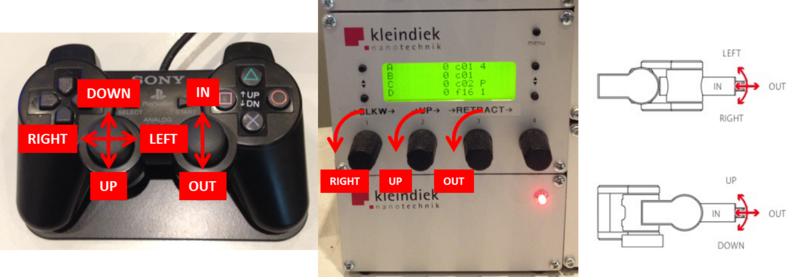LabAdviser/314/Microscopy 314-307/SEM/Nova/Micro 4-point probe: Difference between revisions
Appearance
Created page with "= Kleindiek micromanipulator = The Kleindiek Nanotechnik MM3A-EM is a plug and play micromanipulator for SEM/FIB applications, with a versatile range of modular plug-ins. The..." |
|||
| Line 38: | Line 38: | ||
[[image:Module schematics.PNG|800x800px|center|thumb|Figure 4: module schematics of the SEM Module system with all its components.]] | [[image:Module schematics.PNG|800x800px|center|thumb|Figure 4: module schematics of the SEM Module system with all its components.]] | ||
The electrical resistivity of metallic bulk and thin-�lm samples is usually | |||
measured by the 4-point probe technique. The classic arrangement, visible | |||
in Fig. 2.15, consists of four needle-like electrodes in a linear arrangement, | |||
with a current injected into the material via the outer two electrodes, while | |||
the resulting di�erence in electric potential is measured via the two inner | |||
electrodes. | |||
By using separate electrodes for the current injection and for the determination | |||
of the electric potential, the contact resistance between the metal | |||
electrodes and the material does not show up in the measured results. Since | |||
the contact resistance can be large and can strongly depend on the condition | |||
and materials of the electrodes, it is easier to interpret the data measured | |||
by the 4-point probe technique than from a 2-point probe system. | |||
If the sample has a �nite size and if the spacing between the probes is | |||
s1= s2 = s3 = s, the resistivity is given by: | |||
� = 2a�s | |||
V | |||
I | |||
where a is the thickness correction factor for thicknesses t equal to or less | |||
than half the probe spacing (t=s < 0:5): | |||
Substituting Eq. 2.9 in Eq. 2.8 we get: | |||
If both sides of Eq. 2.10 are divided by t we get: | |||
which we refer to as sheet resistance. When the thickness t is very small | |||
respect to the spacing s, Rs is the preferred measurement quantity, being | |||
independent of any geometrical dimension and therefore a function of the | |||
material alone. | |||
In this thesis, a variation of the classic 4-point probe method was used, | |||
called micro 4-point probe (�4PP) [17]. This because the electrodes of the 4- | |||
point probe can easily scratch a metallic �lm with thickness in the nm range, | |||
thus reaching the substrate and giving inaccurate electrical measurements | |||
as result. Fig. 2.16a shows a �4PP probe chip. Visible are the ceramic | |||
substrate, the Ag/Pd connector strips and the Si base from which the four | |||
cantilevers extend. For the movements, the probe chip is connected to a | |||
micromanipulator inside a SEM. Aided by SEM imaging, the probe gently | |||
touches the thin-�lm surface in 2-point probe mode without scratching it, | |||
followed by the collection of the data in 4-point probe mode (Fig. 2.16b). | |||
Revision as of 10:37, 9 July 2018
Kleindiek micromanipulator
The Kleindiek Nanotechnik MM3A-EM is a plug and play micromanipulator for SEM/FIB applications, with a versatile range of modular plug-ins. The MM3A-EM can be used in most SEM/FIB instruments and offers fast setup and removal. The system consists of a base over which the micromanipulator arm is mounted (Figure 1). The base can be attached to the SEM front door by two exagonal head screws (Figure 2).The arm is connected to the external power supply through two plug-ins on a PCB board mounted on the SEM door.




